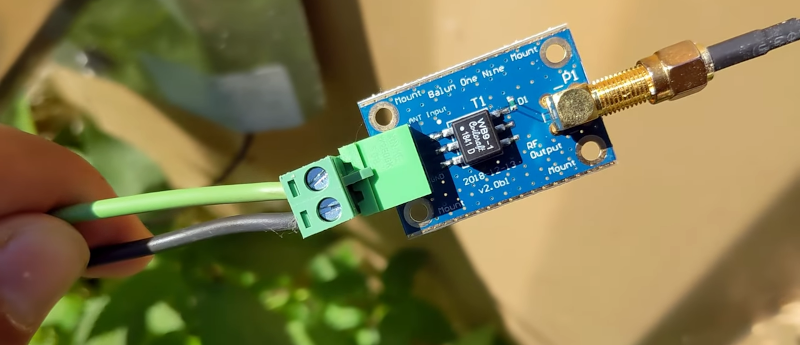Dipoles are a classic builder’s antenna, after all they are usually little more than two pieces of wire and a feedline. But as [Rob] shows us in the video below, there are a few things to consider.
The first thing is where to get the wire. A damaged extension cord donated the wire. That’s actually an interesting idea because you get multiple wires the same length inside the extension cord. Of course, it is easy to just pull the conductors out of the extension cord, but how do you feed it? A small balun converts the unbalanced feed line into a balanced connection for the antenna. Although the title says “free dipole” this balun is commercial and probably cost something unless you happen to already have one. However, building a balun isn’t all that tricky, either if you happen to have a ferrite toroid.
If you want to transmit, you’ll probably need a little different arrangement, but for receiving this will definitely get the job done. A tuner would make life easier.
Even though this is technically a dipole, without tuning it is more of a random wire. However, it works and with antenna analyzers now common gear, it would be easy to shorten the dipole down to any band you wanted.
Of course, in the mechanical world, they say if you can’t make it exact, make it adjustable. If you are looking for cheap station gear, there’s always the $50 ham, otherwise known as [Dan Maloney].
















Although the title says “free dipole” …
No. No it doesn’t.
Ok you meant the title of the video.
So isn’t this about quite high in frequency?
In a pinch, you can get a dipole by using AC line cord, keep it together as feedline until you split it for the actual dipole. But that’s for shortwave frequencies.
Please link as many of the youtube channels or online learning resources you think people starting out EE should watch as you can.
Google for KM4ACK, Dave Casler and/or Ham radio crash course HRCC for a starter. 73 de SA5QED
Sssshhhhh, there are 5th graders listening. Literally.
Slow news day.
That burn barrel might be a good antenna with a probe inside. I’m guessing 420-450 MHz band.
Some of us are just getting into radio and find this helpful. Not everyone is in the same lane. That’s what makes this community so fantastic.
The BalUn can be dispensed with and the coax connected directly to the elements. The trade of is no more significant than a slight distortion in the radiated field. Which is generally an insignificant issue.
For multiple bands just add more elements connected in parallel but cut the apropratelength for the required frequency
The purists may have a fit but if you want a “free” antennae you can’t get much simpler.
Receivers are not often actually 50 Ohms impedance. Many are much higher. Matching may be totally unnecessary. For transmitting, yes, you want to be matched. That antenna (or any antenna) should be disconnected when not in use unless you have proper lightning protection and grounding.
A dipole does not work properly unless it is elevated. 3 feet won’t do it. 30 feet is marginal. A random unmatched chunk of wire on the ground into a high impedance receiver will give you some signal but please do not call it a dipole. Directional properties will be anybody’s guess. Given that atmospheric noise is very high in the HF bands a better antenna will not necessarily give you any better reception. You just get more noise along with the signal and the signal/noise ratio does not improve.
I like to say “Just right is all wrong” as a more aggressive version of “If you can’t make it exact make it adjustable”.
As in, even if you CAN make it exact, it sucks compared to designs that don’t need to be. Precision can be just as delicate as complexity, and it can’t adapt when the thing it’s supposed to fit gets bent.
As a young and very poor ham, my first antenna for 2m was a short piece of coax and 2 pieces of wire connected by a “sugarcube” (screwconnector).
I taped it fo the inside of my window (horizontally polarized) and with that I got a contact with the MIR space station, unfortunately, they kept repeating my callsign wrong and it never got confirmed.
I also made a tropo contact and some Aurora Borealis bouncing with that antenna, befor I finally got a permit to put up a Yagi (I was renting an apartment at the time)
I reused it for years as a travel antenna, and made new ones for my HT’s later on.
I even had it taped to the car window for a cross country trip in a borrowed car.
A dipole is a really cheap, good working, simple antenna that you always can make in a pinch if needed.
The cheapest one is just to strip the right length of the end of the coax and use the screen as one leg and the inner conductor as the other, all you need is a coax…